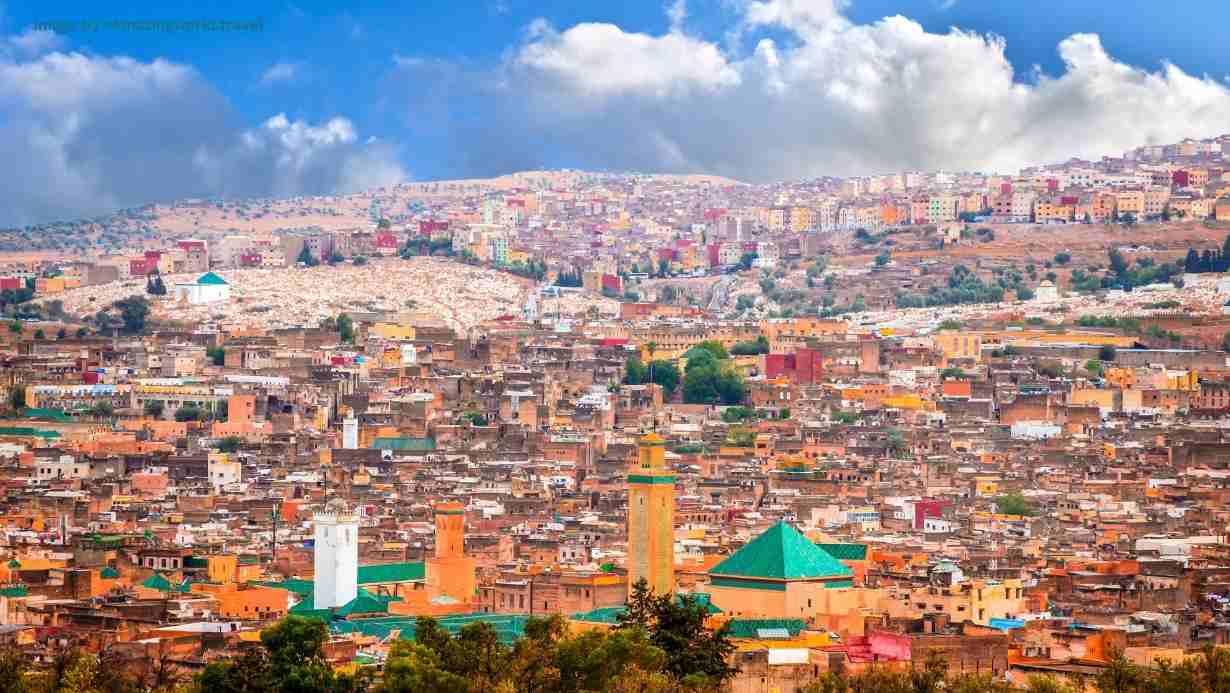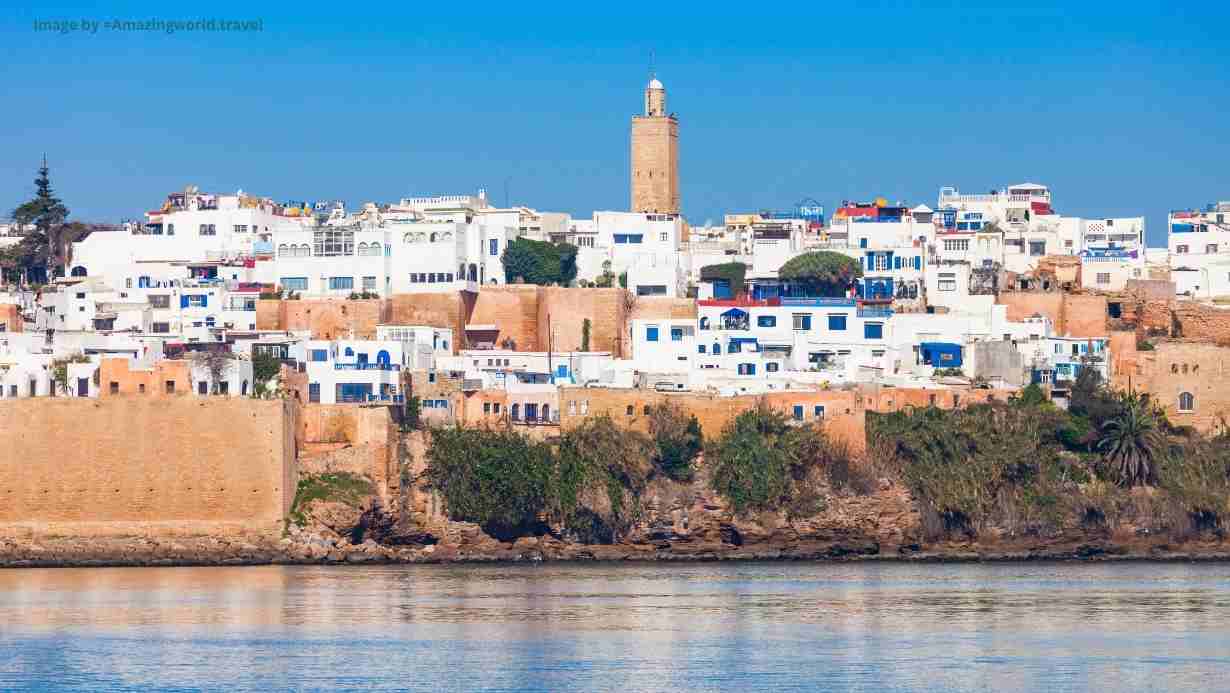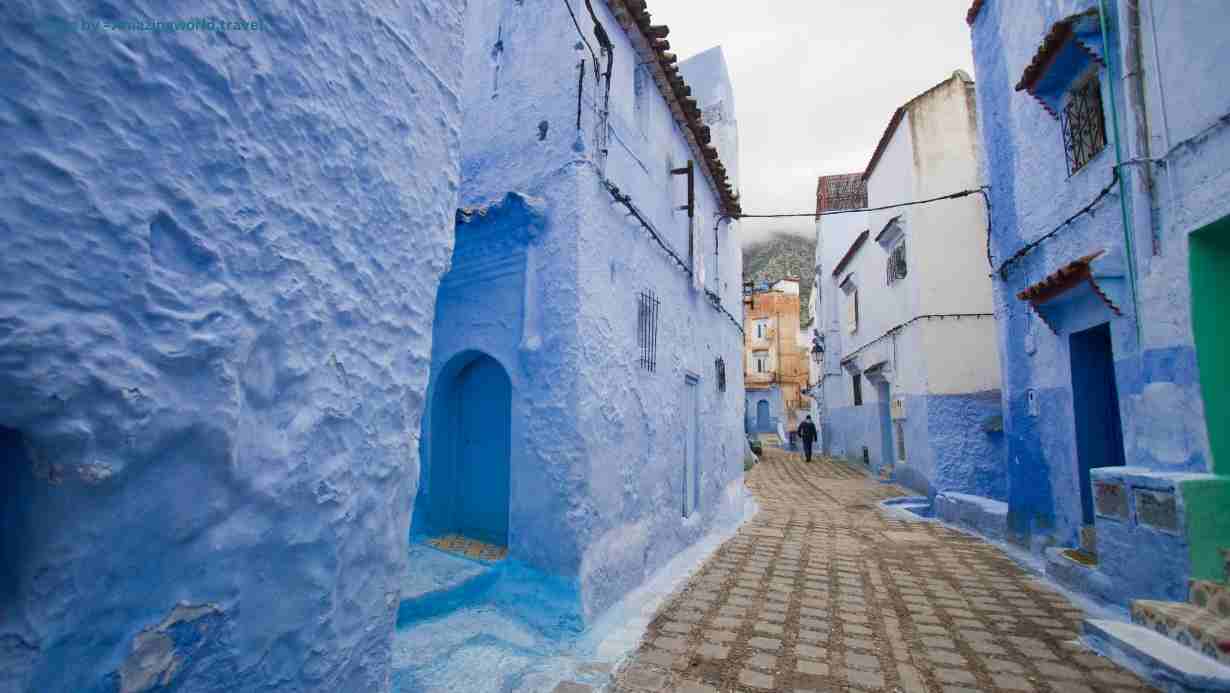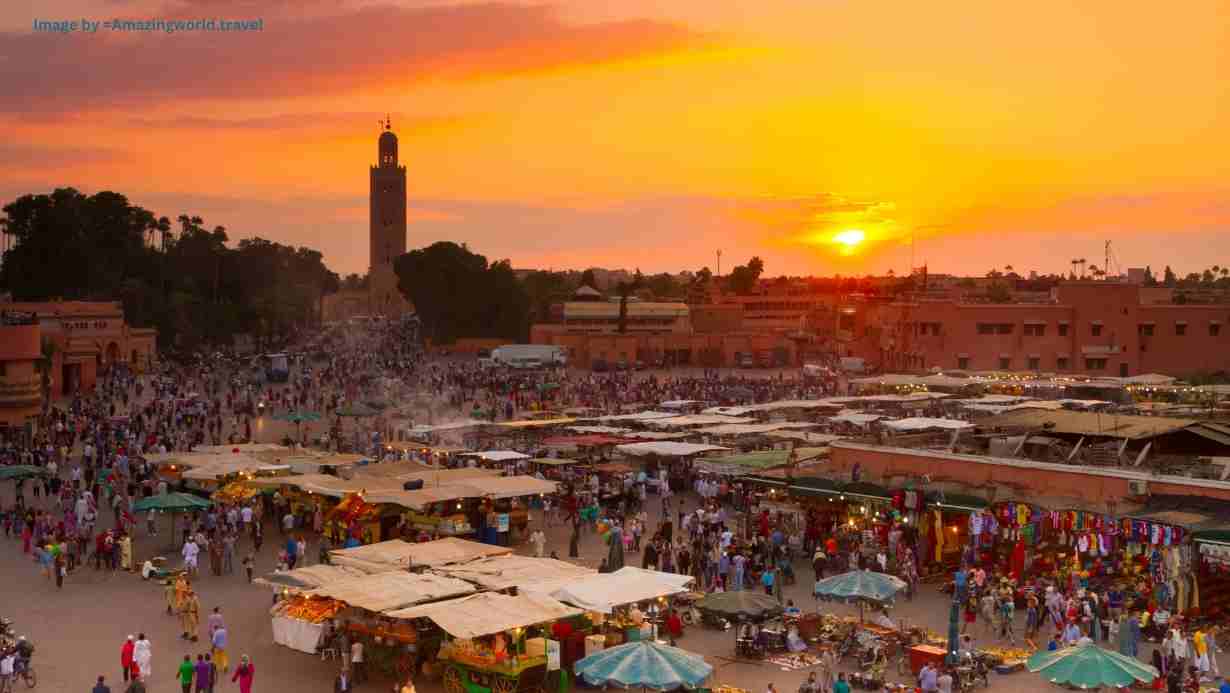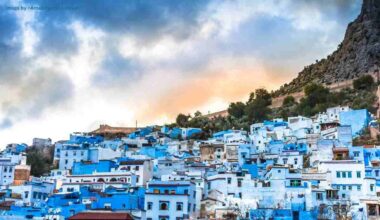Best Time to Visit Morocco (Month-on-Month Guide) – (2024 Updated)
Welcome to the mesmerizing world of Morocco! This North African gem is a land of enchantment, where vibrant colors, rich history, and captivating landscapes converge. From bustling souks to ancient medinas, and from majestic landmarks to breathtaking natural wonders, Morocco has a plethora of popular attractions that will leave you awestruck.
About Morocco country: An overview
Morocco country, situated in North Africa, boasts a diverse cultural blend shaped by Arab, Berber, European, and African influences. Known for its hospitality and tolerance, Morocco is a captivating mix of history, art, and cuisine.
Its strategic location across the Strait of Gibraltar from Spain has influenced its rich heritage. The country’s terrain features striking mountain ranges and overlooks both the Mediterranean Sea and the Atlantic Ocean. Morocco was a French protectorate from 1912 to 1956.
The Kingdom of Morocco embraces a multifaceted identity, blending African, Arab, and Amazigh (Berber) elements, creating a unique cultural tapestry. The Sa’adi monarchy’s reign during the 16th century marked a prosperous era, notably under Ahmad al-MANSUR. This history, coupled with its diverse landscapes and vibrant culture, makes Morocco a fascinating destination for travelers seeking an enriching experience.
How to get to Morocco?
By Air:
International Flights: Most visitors arrive in Morocco via international flights to major airports like Marrakech Menara Airport (RAK), Casablanca Mohammed V International Airport (CMN), and Fes-Saïs International Airport (FEZ). These airports have connections to numerous cities worldwide.
Airlines: Airlines such as Royal Air Maroc, Air France, Emirates, British Airways, and others operate flights to Morocco from major cities across Europe, North America, the Middle East, and other continents.
By Sea: Morocco has several ports along its coastline, and some travelers prefer to arrive by ferry. Popular ferry routes connect Spain (from ports like Algeciras, Tarifa, and Malaga) to Moroccan cities like Tangier and Ceuta.
By Land: Overland travel to Morocco is possible from neighboring countries such as Algeria and Mauritania. However, it’s essential to check border crossing regulations and travel advisories beforehand.
Visa Requirements: Visitors from many countries do not need a visa for short-term stays (usually up to 90 days) for tourism purposes. However, visa requirements vary by nationality, so it’s crucial to check the specific visa regulations for your country before traveling.
Transport Within Morocco: Once in Morocco, transportation options include domestic flights, trains, buses, and rental cars to travel between cities and regions. Major cities have well-connected transportation networks, and intercity travel is relatively efficient.
What is Morocco known for?
Morocco is known for its rich cultural heritage, stunning landscapes, vibrant cities, and one-of-a-kind experiences. Morocco is well-known for several things, including:
- Moroccan culture is a fusion of Arab, Berber, and African influences, which can be seen in its traditions, cuisine, music, and art. The diverse population of the country contributes to the country’s multicultural ethos.
- Historical Wonders: Ancient cities such as Marrakech, Fez, and Meknes have fascinating medinas (old towns) with labyrinthine streets, historic palaces, and architectural wonders such as the Koutoubia Mosque and the Medersa Ben Youssef.
- Moroccan artisans are well known for their intricate craftsmanship, which can be seen in items such as vibrant textiles, pottery, ceramics, leather goods, brass and metalwork, and the famous Moroccan carpets.
- Moroccan cuisine is celebrated around the world for its flavors and spices. Couscous, tagines (slow-cooked stews), pastilla (a savory pastry), and flavorful mint tea are popular dishes. Food markets and street vendors provide a delectable culinary experience.
- Morocco’s vast Sahara Desert is an iconic destination, offering camel treks, camping under the stars, and the chance to explore the mesmerizing dunes of Merzouga and Erg Chebbi.
- The Atlas Mountains offer breathtaking landscapes, trekking opportunities, and access to traditional Berber villages, providing insights into rural Moroccan life and culture.
- Beautiful beaches, coastal towns like Essaouira, and water sports like surfing and kiteboarding can be found along Morocco’s Atlantic and Mediterranean coasts.
- Moroccans are known for their warm hospitality, greeting visitors with traditional mint tea and genuine friendliness.
- Morocco’s varied landscapes have been featured in several films and television shows, including “Gladiator,” “Game of Thrones,” and “The Mummy,” among others.
- Colorful Festivals and Events: Morocco hosts several festivals throughout the year that celebrate music, dance, art, and religious traditions, such as the Mawazine Music Festival and the Gnaoua World Music Festival.
Morocco’s allure stems from its diverse offerings, which range from ancient history and cultural riches to natural wonders and warm hospitality, making it an enticing destination for travelers looking for an authentic and immersive experience.
Understanding Morocco Seasons
Morocco’s diverse climate offers something for everyone, no matter what season you choose to visit. Here’s a breakdown of each season to help you plan your perfect trip:
Spring (March to May):
- Weather: Pleasant and sunny, with temperatures in the 70s and 80s °F (21-27°C). Perfect for outdoor activities.
- Crowds: Moderate, with fewer tourists compared to summer.
- Ideal for Hiking in the Atlas Mountains, exploring cities, enjoying beaches, and attending festivals like the Rose Festival in Kelaat M’Gouna or the Mawazine Festival in Rabat.
Summer (June to August):
- Weather: Hot and sunny, with temperatures often exceeding 100°F (38°C). Expect scorching days, especially in inland areas.
- Crowds: Peak season, with bustling beaches and tourist hotspots.
- Ideal for: Relaxing on the beach, swimming in the ocean, enjoying nightlife, and attending festivals like the Essaouira Kite Festival or the Fantasia Horse Show in Meknes.
Autumn (September to November):
- Weather: Comfortable and sunny, with warm days and cool nights. Temperatures in the 70s and 80s °F (21-27°C).
- Crowds: Smaller crowds compared to summer, offering more peaceful exploration.
- Ideal for: Hiking, exploring cities, desert safaris, and attending the Fantasia Festival in Marrakech or the International Film Festival in Marrakech.
Winter (December to February):
- Weather: Mildest time of year, with temperatures in the 60s and 70s °F (15-21°C). Occasional rain and snow in the mountains.
- Crowds: Lowest number of tourists, ideal for those seeking solitude.
- Ideal for: Skiing in the High Atlas Mountains, exploring the Sahara Desert, visiting southern cities like Agadir, and experiencing Christmas and New Year’s celebrations in Marrakech.
Month-by-Month Guide for Traveling in Switzerland
January in Morocco
Best Places to Visit in Morocco:
January in Morocco offers a diverse range of destinations to explore, each with its unique charm and appeal:
- Marrakech: Marrakech, with its bustling souks, historical sites like the Jardin Majorelle, and the vibrant Djemaa el-Fna square, remains a top attraction. In January, the city experiences mild temperatures during the day, perfect for exploring its cultural treasures.
- Fez: Fez, known for its well-preserved ancient medina, offers a glimpse into Morocco’s rich history. The cooler weather in January allows visitors to wander through the narrow lanes, visit the tanneries, and explore the historic mosques and madrasas.
- Atlas Mountains: The Atlas Mountains present a breathtaking winter landscape during January. Travelers can engage in activities like hiking, skiing (especially in areas like Oukaimeden), or visiting traditional Berber villages.
Why Choose January for a Visit?
Visiting Morocco in January has its advantages:
- Mild Weather: January in Morocco generally experiences mild temperatures, making it comfortable for outdoor activities and sightseeing without the extreme heat of summer.
- Fewer Crowds: Compared to the peak tourist seasons, January sees fewer tourists, allowing visitors to enjoy attractions with less congestion and more tranquility.
- Winter Landscapes: The Atlas Mountains offer stunning winter scenery, with snow-capped peaks and picturesque landscapes, providing unique photo opportunities.
Activities and Things to Do:
- Sightseeing: Explore the historical sites, ancient medinas, and architectural wonders in cities like Marrakech, Fez, and Rabat.
- Outdoor Adventures: Engage in activities like hiking, trekking, or skiing in the Atlas Mountains, which showcase breathtaking winter vistas.
- Cultural Immersion: Attend local workshops, visit artisan markets, and experience traditional Moroccan culture, including mint tea ceremonies and local cuisine.
Events & Festivals:
- Imilchil Marriage Festival: Although it usually occurs in September, the Imilchil Marriage Festival in January might still offer glimpses into Berber traditions.
- Almond Blossom Festival: Some regions, particularly in the Tafraoute area, might celebrate the blooming of almond trees in January.
Things to Avoid:
- Unpreparedness for Weather: While it’s generally mild, weather variations might occur, especially in the mountains. Prepare with appropriate clothing for both mild and cooler temperatures.
- Underestimating Crowds: Although fewer tourists visit in January, popular attractions might still have moderate crowds, so plan accordingly to avoid disappointment.
Visiting Morocco in January presents an opportunity to explore diverse landscapes, experience cultural authenticity, and enjoy a relatively peaceful atmosphere while discovering the country’s treasures.
February in Morocco
Best Places to Visit in Morocco:
February continues to offer a variety of enchanting destinations for travelers:
- Essaouira:Known for its charming coastal vibe, Essaouira beckons visitors with its historic medina, sandy beaches, and vibrant art scene. The mild February weather makes it an excellent time for beach walks and water sports.
- Chefchaouen: The “Blue City” of Chefchaouen captivates with its picturesque blue-washed buildings. February provides a quieter atmosphere, allowing visitors to explore its narrow streets and enjoy its tranquil ambiance.
- Sahara Desert: While the Sahara Desert can be chilly at night, February offers moderate daytime temperatures, making it an opportune time for camel treks, camping under the stars, and experiencing the vast desert landscape.
Why Choose February for a Visit?
February in Morocco presents several compelling reasons for travel enthusiasts:
- Moderate Climate: February brings pleasant temperatures across many regions, making it comfortable for outdoor activities without the summer heat.
- Off-Peak Season: It’s still relatively less crowded compared to peak tourist months, allowing for more intimate experiences at popular sites.
- Festival and Event Highlights: Some areas may host cultural events or festivals, offering a chance to witness local traditions and celebrations.
Activities and Things to Do:
- Coastal Explorations: Enjoy beach activities, seafood dining, and exploring the laid-back atmosphere of coastal towns like Essaouira or Agadir.
- Hiking and Nature Trails: Take advantage of the milder weather for trekking in the Rif Mountains or exploring nature reserves like Toubkal National Park.
- Cultural Immersion: Engage with locals, visit art galleries, and immerse yourself in the unique ambiance of cities like Chefchaouen, known for its artistic community.
Events & Festivals: Almond Blossom Festivals: In some regions, February marks the continuation of almond blossom festivals, celebrating the beauty of blooming almond trees.
Things to Avoid:
- Assuming Consistent Weather: While generally mild, weather fluctuations can occur, especially in mountainous or desert areas. Pack layers to accommodate varying temperatures.
- Overlooking Advance Bookings: Despite lower tourist numbers, popular accommodations or tours may still require bookings, especially in sought-after destinations.
February in Morocco offers a delightful balance between pleasant weather, cultural exploration, and diverse landscapes, making it an ideal time for travelers seeking an authentic Moroccan experience with fewer crowds.
Best Places to Visit in Morocco:
March in Morocco offers a range of captivating destinations with pleasant weather and cultural richness:
- Meknes: Known for its imperial past, Meknes showcases architectural marvels like Bab Mansour and the historic granaries of Heri es-Souani. The moderate climate in March allows for exploration without the scorching heat.
- Tangier: Tangier’s unique position at the meeting point of the Atlantic Ocean and the Mediterranean Sea makes it a cultural melting pot. Visitors can explore its medina, art galleries, and historical sites while enjoying comfortable temperatures.
- Agadir: As a popular coastal resort town, Agadir beckons travelers with its sandy beaches, seaside promenades, and relaxing atmosphere. March offers pleasant weather for beach activities and strolls.
Why Choose March for a Visit?
March presents an ideal time to explore Morocco for several compelling reasons:
- Mild Weather: The weather in March is typically mild and comfortable across various regions, making it perfect for outdoor activities and sightseeing without the intensity of summer heat.
- Cultural Immersion: The moderate tourist season allows for more authentic interactions with locals and a deeper dive into Moroccan traditions and customs.
- Diverse Activities: From exploring historical sites to enjoying coastal escapes or engaging in outdoor adventures, March offers a diverse range of activities catering to different preferences.
Activities and Things to Do:
- Exploring Historical Sites: Discover the rich heritage of cities like Meknes, Rabat, and Tangier by visiting ancient medinas, historic landmarks, and architectural wonders.
- Beach Relaxation: Enjoy the coastal charm of destinations like Agadir or Essaouira, indulging in beach activities, watersports, and leisurely walks along the shorelines.
- Hiking and Nature Excursions: Venture into the Atlas Mountains or national parks for scenic hikes, exploring nature trails, and immersing in Morocco’s natural beauty.
Events & Festivals:
- International Nomad Festival: In certain regions, March might feature the International Nomad Festival, celebrating nomadic culture with music, dance, and traditional displays.
Things to Avoid:
- Underestimating Sun Exposure: While the weather is mild, the sun can still be strong. Visitors should use sunscreen, hats, and protective clothing, especially during outdoor activities.
- Ignoring Local Customs: Respect local customs and dress modestly, especially when visiting religious sites or more conservative areas, to avoid any inadvertent cultural offense.
March in Morocco offers a delightful blend of moderate weather, cultural exploration, and a diverse range of activities, making it an opportune time for travelers to experience the country’s rich tapestry in a relaxed and enjoyable manner.
April in Morocco
Best Places to Visit in Morocco:
April in Morocco invites travelers to explore various captivating destinations:
- Casablanca: As a bustling modern city, Casablanca offers a blend of contemporary life and historical landmarks like the Hassan II Mosque, Corniche Ain Diab, and vibrant markets. In April, the city experiences pleasant temperatures for exploration.
- Rabat: The capital city, Rabat, boasts historical sites such as the Kasbah of the Udayas, Chellah Necropolis, and the Royal Palace. April provides favorable weather for discovering its cultural treasures.
- Ouarzazate: Known as the gateway to the Sahara Desert, Ouarzazate is famed for its movie studios, ancient kasbahs like Ait Ben Haddou, and the stunning Atlas Film Studios. April offers comfortable temperatures for exploring the desert environs.
Why Choose April for a Visit?
April presents an enticing time to visit Morocco for several reasons:
- Springtime Blooms: April heralds the arrival of spring, adorning landscapes with colorful blossoms and lush vegetation, enhancing the scenic beauty across the country.
- Moderate Weather: The weather in April remains mild and pleasant, ideal for outdoor activities, sightseeing, and exploring various regions without extreme temperatures.
- Cultural Experiences: With the moderate tourist influx, travelers can immerse themselves more deeply in local culture, interact with residents, and witness authentic traditions and festivals.
Activities and Things to Do:
- City Exploration: Discover the vibrant city life and historical landmarks in cities like Casablanca, Rabat, and Tangier, where moderate temperatures allow for comfortable walks and sightseeing.
- Sahara Desert Excursions: Venture into the Sahara Desert on camel treks or 4×4 tours, visit ancient kasbahs, and witness mesmerizing sunsets amidst the desert landscape.
- Cultural Immersion: Engage in local markets, savor traditional cuisine, and participate in cultural activities or workshops, gaining insights into Morocco’s diverse heritage.
Events & Festivals: Marrakech Popular Arts Festival: April might feature the Marrakech Popular Arts Festival, celebrating Moroccan traditional music, dance, and arts in the city’s vibrant atmosphere.
Things to Avoid:
- Overpacking for Heat: While temperatures are mild, it’s advisable to pack layers for cooler evenings or if traveling to higher elevations like the Atlas Mountains.
- Underestimating Crowds: Though not as busy as peak seasons, popular tourist sites may still have moderate crowds, especially during holidays or festivals. Plan visits accordingly.
April in Morocco offers a delightful fusion of springtime beauty, moderate weather, and diverse cultural experiences, making it an excellent time for travelers seeking a balanced exploration of Morocco’s heritage and landscapes.
May in Morocco
Best Places to Visit in Morocco:
May presents an array of captivating destinations to explore across Morocco:
- Marrakech: Known for its vibrant medina, historical sites like the Bahia Palace, and the lively Jemaa el-Fna square, Marrakech is a cultural hub. May offers pleasant temperatures for exploring its bustling streets and markets.
- Atlas Mountains: May provides an excellent opportunity to explore the stunning Atlas Mountains. Visitors can engage in hiking, trekking, or visiting Berber villages to witness the mountainous landscapes and local traditions.
- Merzouga (Sahara Desert): Merzouga, famous for its majestic sand dunes, offers an unforgettable desert experience. May offers relatively moderate temperatures for camel treks, camping, and enjoying the desert scenery.
Why Choose May for a Visit?
May is an appealing time to visit Morocco for several reasons:
- Mild Spring Weather: May signifies the arrival of spring in full bloom, offering mild and pleasant temperatures across most regions, making it ideal for outdoor exploration.
- Flourishing Landscapes: The countryside blossoms with greenery and colorful flora, creating picturesque landscapes and enhancing the natural beauty of Morocco.
- Festivals and Celebrations: Various cultural events and festivals take place in May, providing opportunities to witness traditional music, dance, and local festivities.
Activities and Things to Do:
- Exploring Marrakech: Dive into Marrakech’s vibrant culture, visit historical sites, shop at souks, and experience the city’s energetic ambiance during the comfortable May weather.
- Atlas Mountains Adventures: Engage in hiking trails, nature walks, or cultural tours in the Atlas Mountains, interacting with local communities and enjoying the stunning mountain vistas.
- Sahara Desert Excursions: Experience the magic of the Sahara Desert through camel treks, camping, and enjoying the serene desert landscapes in places like Merzouga or Zagora.
Events & Festivals: Gnaoua World Music Festival: May may feature the Gnaoua World Music Festival in Essaouira, celebrating music and cultural diversity with performances and artistic showcases.
Things to Avoid:
- Underestimating Sun Protection: Despite mild temperatures, the sun can be strong. It’s essential to use sunscreen, wear hats, and stay hydrated during outdoor activities.
- Overlooking Cultural Sensitivity: Respect local customs, particularly during festivals or in more conservative areas, by dressing modestly and adhering to cultural norms.
May in Morocco offers a vibrant tapestry of cultural experiences, natural beauty, and favorable weather conditions, providing an excellent opportunity for travelers to immerse themselves in the country’s diverse landscapes and rich heritage.
June in Morocco
Best Places to Visit in Morocco:
June offers a spectrum of enticing destinations to explore:
- Essaouira: Essaouira’s coastal charm remains inviting in June, with its sandy beaches, historic medina, and art scene. The pleasant weather allows for beach activities and leisurely explorations.
- Chefchaouen: The “Blue City” of Chefchaouen maintains its allure in June with its picturesque blue-washed buildings. Visitors can explore its serene streets, visit local artisans, and enjoy the cooler mountain climate.
- Dades Valley: Dades Valley, known for its stunning gorges and picturesque landscapes, offers pleasant temperatures in June, making it an ideal time for hiking, exploring the valley, and experiencing its natural beauty.
Why Choose June for a Visit?
June presents unique reasons to explore Morocco:
- Coastal Escapes: Coastal towns like Essaouira offer a pleasant respite from the summer heat, with refreshing sea breezes and enjoyable beach activities.
- Moderate Temperatures: In regions like Chefchaouen and the Atlas Mountains, June offers comfortable temperatures for exploration without the scorching heat experienced in midsummer.
- Favorable for Outdoors: June allows for various outdoor activities, including beach outings, hiking, and exploring the diverse landscapes, thanks to the comfortable weather conditions.
Activities and Things to Do:
- Coastal Relaxation: Enjoy beach activities, water sports, or simply unwind along the coastline in places like Essaouira or Agadir, taking advantage of the moderate temperatures.
- Cultural Immersion: Explore the unique atmosphere of Chefchaouen, wandering through its blue alleys, visiting local artisans, and experiencing the town’s artistic community.
- Outdoor Adventures: Engage in hiking trails, nature walks, or cultural tours in the Atlas Mountains or valleys like Dades, reveling in the scenic beauty and cooler climate.
Events & Festivals: Fes Sacred Music Festival: June might feature the Fes Sacred Music Festival, celebrating world music and spiritual traditions, offering unique musical performances and cultural experiences.
Things to Avoid:
- Overpacking for Heat: While temperatures are generally moderate, it’s advisable to pack light clothing suitable for warmer days, especially in inland areas.
- Underestimating Sun Protection: Even with moderate temperatures, sun protection remains crucial. Apply sunscreen and stay hydrated during outdoor activities.
June in Morocco presents a wonderful opportunity for travelers seeking coastal escapes, mountain adventures, and cultural immersions amidst comfortable temperatures, making it an enjoyable time to explore the diverse facets of the country’s landscapes and heritage.
July in Morocco
Best Places to Visit in Morocco:
July offers an array of captivating destinations across Morocco:
- Tangier: Tangier’s unique location at the crossroads of the Mediterranean and the Atlantic makes it a cultural hotspot. In July, the city experiences warm temperatures, perfect for beach visits and exploring its historical sites.
- Agadir: As a popular coastal resort town, Agadir beckons with its beautiful beaches and relaxed atmosphere. July provides ideal weather for beach activities and leisurely seaside strolls.
- Todgha Gorges: Todgha Gorges, known for its breathtaking canyon and natural beauty, offers slightly cooler temperatures in July, making it suitable for trekking, sightseeing, and enjoying the stunning landscapes.
Why Choose July for a Visit?
July brings forth certain advantages for exploring Morocco:
- Beach Getaways: Coastal towns like Tangier and Agadir offer warm weather, ideal for indulging in beach activities, water sports, and soaking up the Mediterranean and Atlantic vibes.
- Longer Days for Exploration: July brings longer daylight hours, allowing for extended explorations and activities, whether at the beach, in the cities, or exploring nature.
- Lively Atmosphere: The summer months attract a vibrant energy with locals and tourists alike, offering a lively ambiance and various entertainment options.
Activities and Things to Do:
- Beach Escapes: Enjoy the sun, sea, and sand in coastal towns like Tangier and Agadir, engaging in activities like swimming, surfing, or simply relaxing by the shore.
- Exploring Cities: Wander through the historical sites, markets, and cultural landmarks of cities like Tangier or Rabat, taking advantage of the warm weather for sightseeing.
- Nature Exploration: Visit scenic spots like Todgha Gorges for hiking, nature walks, or photography amidst the impressive canyon landscape.
Events & Festivals:
- National Throne Day: Celebrated on July 30th, National Throne Day commemorates the ascension of the King of Morocco to the throne, marked with patriotic events and ceremonies.
Things to Avoid:
- Overexposure to the Sun: As July can be hot, it’s crucial to stay hydrated, use sunscreen, and seek shade during peak sun hours to avoid sunburn and heat-related issues.
- Crowded Tourist Spots: Popular tourist destinations may experience increased crowds during the summer months, so plan visits accordingly to avoid large queues or congestion.
July in Morocco offers a blend of coastal relaxation, cultural experiences, and opportunities to explore nature, catering to travelers seeking warm weather and a vibrant atmosphere during their Moroccan adventure.
August in Morocco
Best Places to Visit in Morocco:
August boasts a variety of enchanting destinations for travelers to explore:
- Marrakech: Marrakech remains a vibrant hub, offering historical sites like the Koutoubia Mosque and the bustling souks of the medina. In August, while temperatures are high, the city’s cultural richness continues to attract visitors.
- Atlas Mountains: The Atlas Mountains present a cooler escape in August compared to lower-lying regions. Travelers can enjoy trekking, exploring Berber villages, and experiencing the mountainous landscapes.
- Merzouga (Sahara Desert): Despite the heat, Merzouga offers a unique desert experience in August. Camel treks, overnight camping, and experiencing the vast dunes of the Sahara remain highlights, albeit with the need for extra precautions due to high temperatures.
Why Choose August for a Visit?
August presents specific reasons for exploring Morocco:
- Summer Vibes: August offers a summertime atmosphere, ideal for beach visits, mountain retreats, and experiencing the vibrant culture of cities like Marrakech.
- Festive Atmosphere: The summer months often bring a lively ambiance with various entertainment options, events, and cultural activities across different regions.
- Extended Daylight: Longer daylight hours in August provide more time for sightseeing and engaging in activities throughout the day.
Activities and Things to Do:
- City Exploration: Discover Marrakech’s bustling markets, historical sites, and architectural wonders while taking breaks in shaded areas to escape the heat.
- Mountain Adventures: Escape the summer heat by exploring the Atlas Mountains, engaging in trekking, visiting traditional villages, and enjoying cooler temperatures at higher altitudes.
- Desert Excursions: Experience the Sahara Desert with caution, engaging in camel treks, camping, and watching stunning sunsets, while being mindful of the high temperatures.
Events & Festivals: Imilchil Marriage Festival: In August, some regions may celebrate the Imilchil Marriage Festival, showcasing Berber traditions and cultural ceremonies.
Things to Avoid:
- Heat-related Issues: August can be extremely hot, especially in desert areas. Travelers should stay hydrated, seek shade, and limit outdoor activities during peak sun hours to avoid heat exhaustion.
- Overpacking for Summer: Pack lightweight clothing, sunscreen, and hats, and stay hydrated to cope with the intense summer heat, especially in desert or lowland regions.
August in Morocco offers a blend of cultural experiences, outdoor adventures, and a lively atmosphere, catering to travelers seeking diverse landscapes and the allure of Moroccan heritage, albeit with considerations for the higher temperatures prevalent during this time.
September in Morocco
Best Places to Visit in Morocco:
September invites exploration of diverse destinations across the country:
- Fez: Fez, renowned for its ancient medina and historical sites like the Al-Attarine Madrasa, offers a pleasant climate in September for immersive cultural experiences.
- Chefchaouen: The picturesque blue-hued streets of Chefchaouen retain their charm in September with milder temperatures, ideal for leisurely explorations and engaging with local artisans.
- Ait Ben Haddou: Ait Ben Haddou, a UNESCO World Heritage Site, showcases stunning kasbahs and desert landscapes. September offers favorable weather for touring this historic site.
Why Choose September for a Visit?
September presents appealing attributes for visiting Morocco:
- Transitional Weather: September marks the transition from summer to autumn, providing comfortable temperatures across various regions for outdoor activities and sightseeing.
- Reduced Crowds: With the peak tourist season winding down, September offers a quieter atmosphere at popular attractions, allowing for more intimate experiences.
- Favorable for Exploration: The mild weather makes it conducive for exploring cities, historical sites, and natural landscapes without the intense heat of summer.
Activities and Things to Do:
- Historical Explorations: Discover the cultural treasures of Fez, explore its labyrinthine medina, and visit historical monuments, enjoying the moderate temperatures.
- Artisanal Encounters: Engage with local artisans in Chefchaouen, known for its vibrant arts scene, and explore the town’s picturesque streets and craft shops.
- Desert Tours: Explore the desert regions like Ait Ben Haddou or Merzouga, enjoying camel treks, discovering ancient kasbahs, and experiencing the desert landscapes.
Events & Festivals: Tan-Tan Moussem: September may host the Tan-Tan Moussem, a traditional festival celebrating local culture, music, and tribal traditions in the Tan-Tan region.
Things to Avoid:
- Underpreparedness for Weather Changes: While temperatures are generally pleasant, regions like the desert or mountains might experience cooler nights, so it’s advisable to carry layers for temperature variations.
- Overlooking Early Bookings: Despite reduced crowds, popular accommodations or tours might still require early bookings, especially in sought-after destinations.
September in Morocco offers a delightful balance between mild weather, cultural exploration, and diverse landscapes, making it an opportune time for travelers seeking a relaxed and immersive experience in this captivating North African country.
October in Morocco
Best Places to Visit in Morocco:
October offers a diverse range of captivating destinations:
- Marrakech: Marrakech continues to enthrall visitors with its vibrant souks, historical sites like the Bahia Palace, and the bustling Djemaa el-Fna square. In October, the city experiences comfortable temperatures for exploration.
- Essaouira: Essaouira’s coastal charm remains inviting in October, with its sandy beaches, art galleries, and laid-back atmosphere. The mild weather makes it an ideal time for beach activities and exploring the city’s culture.
- High Atlas Mountains: The High Atlas Mountains offer stunning landscapes and trekking opportunities. In October, the weather is pleasant for hiking, visiting Berber villages, and enjoying the mountainous scenery.
Why Choose October for a Visit?
October presents several enticing reasons to explore Morocco:
- Mild Autumn Weather: October marks the autumn season, providing comfortable temperatures across most regions, ideal for outdoor activities and sightseeing.
- Favorable for Various Adventures: The mild climate in October allows travelers to engage in diverse activities, whether exploring cities, enjoying beach outings, or trekking in the mountains.
- Cultural Experiences: With fewer tourists compared to the peak season, October offers opportunities for more intimate experiences, interaction with locals, and a deeper dive into Moroccan culture.
Activities and Things to Do:
- Exploring Marrakech: Dive into Marrakech’s lively atmosphere, visit historical sites, and get lost in the vibrant souks while relishing the pleasant October weather.
- Coastal Relaxation: Enjoy the coastal charm of Essaouira, partake in water sports, or simply unwind on the beaches, soaking in the relaxed ambiance of the city.
- Mountain Adventures: Embark on hiking trails in the High Atlas Mountains, experiencing picturesque landscapes, interacting with local communities, and enjoying the cooler mountain climate.
Events & Festivals: Erfoud Date Festival: In October, Erfoud might celebrate the Erfoud Date Festival, honoring the date harvest with cultural events, music, and traditional performances.
Things to Avoid:
- Underestimating Temperature Changes: While days are pleasant, evenings in mountainous areas can be cooler. Packing layers ensures comfort during temperature fluctuations.
- Unplanned Bookings: Despite fewer tourists, popular accommodations or tours may still require advance bookings, especially in sought-after destinations.
October in Morocco presents an ideal balance between mild weather, cultural exploration, and diverse outdoor activities, offering travelers an opportunity to discover the country’s heritage and landscapes in a relaxed and enjoyable manner.
November in Morocco
Best Places to Visit in Morocco:
November offers a variety of captivating destinations to explore:
- Fes: Fes, known for its ancient medina and intricate architecture, maintains its allure in November. Visitors can explore historical sites, traditional markets, and the vibrant culture of this imperial city.
- Dades Valley: Dades Valley, with its stunning gorges and scenic landscapes, provides pleasant temperatures in November, ideal for hiking, sightseeing, and immersing in the natural beauty of the region.
- Tangier: Tangier’s unique position at the meeting point of the Mediterranean and the Atlantic Ocean remains inviting in November. The city offers historical sites, vibrant markets, and a pleasant coastal ambiance.
Why Choose November for a Visit?
November presents compelling reasons to explore Morocco:
- Mild Autumn Climate: November experiences mild temperatures across many regions, making it comfortable for outdoor activities, exploring cities, and visiting historical sites without the summer heat.
- Reduced Crowds: As the peak tourist season winds down, November offers a quieter atmosphere, allowing for more relaxed and intimate experiences at popular attractions.
- Cultural Immersion: With fewer tourists, visitors can engage more deeply in Moroccan culture, interact with locals, and discover traditions and customs authentically.
Activities and Things to Do:
- Exploring Fes: Delve into Fes’ historical heritage by wandering through its medina, visiting mosques, and experiencing the city’s traditional craftsmanship and artisanal culture.
- Nature Excursions: Visit Dades Valley for hikes, exploring the gorges, and enjoying the breathtaking landscapes adorned with autumn hues in November.
- Coastal Strolls: Enjoy leisurely walks along Tangier’s coastline, visit historical landmarks, and savor the city’s cultural blend with pleasant November weather.
Events & Festivals: Independence Day: November 18th marks Morocco’s Independence Day, celebrated with patriotic events, parades, and cultural festivities across the country.
Things to Avoid:
- Unprepared for Cooler Evenings: While daytime temperatures are comfortable, evenings in some areas might be cooler. Packing layers ensures comfort throughout the day.
- Assuming Availability: Despite fewer crowds, certain tours or accommodations might still require bookings, especially during specific events or in popular areas.
November in Morocco offers a delightful blend of mild weather, cultural exploration, and diverse landscapes, making it an opportune time for travelers seeking a tranquil and immersive experience in this enchanting North African country.
December in Morocco
Best Places to Visit in Morocco:
December offers diverse and enchanting destinations to explore:
- Marrakech: Marrakech remains a cultural treasure trove in December with its bustling souks, historical sites, and vibrant atmosphere. Visitors can explore the city’s attractions while enjoying cooler temperatures.
- Sahara Desert (Merzouga): Despite cooler temperatures, the Sahara Desert in places like Merzouga retains its allure in December. Travelers can still experience camel treks, and desert camping, and enjoy the majestic dunes.
- Ourika Valley: The Ourika Valley, nestled in the Atlas Mountains, offers breathtaking scenery and Berber villages. In December, visitors can hike, explore waterfalls, and experience the region’s natural beauty.
Why Choose December for a Visit?
December provides several compelling reasons to explore Morocco:
- Mild Winter Climate: While some areas experience cooler weather, December generally offers mild temperatures across regions, making it comfortable for sightseeing and outdoor activities.
- Festive Atmosphere: December brings a festive vibe with Christmas and New Year’s celebrations, offering a unique cultural blend and a lively ambiance in various cities and towns.
- Scenic Landscapes: The landscapes, especially in mountainous regions, showcase a scenic charm with snow-capped peaks, adding an extra layer of beauty to the surroundings.
Activities and Things to Do:
- Exploring Marrakech: Wander through Marrakech’s historic medina, visit architectural wonders like the Koutoubia Mosque, and immerse in the city’s bustling souks amidst cooler yet pleasant temperatures.
- Desert Adventures: Experience the Sahara Desert in Merzouga with caution due to cooler nights, enjoying camel treks, desert camps, and mesmerizing sunsets over the dunes.
- Mountain Escapes: Explore the Ourika Valley, engage in hikes, visit Berber villages, and witness stunning waterfalls amid the picturesque landscapes.
Events & Festivals: Christmas & New Year Celebrations: While not an official Moroccan holiday, cities like Marrakech and Casablanca often host festivities, events, and decorations for Christmas and New Year’s Eve.
Things to Avoid:
- Underestimating Winter Weather: While generally mild, some regions experience cooler temperatures. Packing layers ensures comfort, especially for visits to higher elevations.
- Last-Minute Reservations: Due to holiday tourism, it’s advisable to secure accommodations and tours in advance, especially in popular destinations during the festive season.
December in Morocco presents a charming blend of mild winter weather, cultural celebrations, and diverse landscapes, offering travelers an opportunity to experience the country’s rich heritage and natural beauty in a unique and festive setting.
Beyond the Seasons: Worst Time to Visit Switzerland
| Aspect | Explanation |
| Weather Extremes | During peak winter (December to February) and sometimes early spring (March), Switzerland experiences harsh weather conditions like heavy snowfall, low temperatures, and limited daylight hours. These conditions can hinder outdoor activities and sightseeing. |
| Crowded Tourist Spots | The peak summer months (June to August) draw crowds to popular destinations, leading to crowded attractions, longer queues, and higher prices for accommodations and tours. |
| Limited Accessibility | In the shoulder seasons, particularly late autumn (October to November) and early spring (April to May), some mountain passes or tourist facilities might be closed or have reduced accessibility due to transitioning between seasons. |
| Unpredictable Weather | The transitional months (April to May and September to October) experience unpredictable weather, with fluctuating temperatures and occasional rainfall, which may impact outdoor activities and travel plans. |
| Higher Accommodation Prices | Events like festivals, international conferences, or special local happenings in various seasons might lead to increased accommodation costs and scarcity of available lodging options. |
Popular Attractions in Morocco
- Marrakesh Medina: Known for its vibrant souks and historical significance
- Chefchaouen: Famous for its blue-washed buildings and picturesque streets
- Erg Chebbi’s Dunes: A stunning desert landscape popular for activities like camel trekking and sandboarding
- Fes el Bali: One of the best-preserved old cities in the Arab-Muslim world, known for its medieval architecture and traditional atmosphere
- Ait Ben Haddou: A well-preserved ancient fortified village, a UNESCO World Heritage site, and a popular filming location
- Essaouira: A coastal town known for its beautiful beaches, historic medina, and artistic atmosphere
- Volubilis: An ancient Roman city and a UNESCO World Heritage site, famous for its well-preserved ruins
- Dades Valley: Renowned for its stunning natural scenery, including dramatic rock formations and picturesque oases
- Hassan II Mosque: Located in Casablanca, it is one of the largest mosques in the world and a significant religious and architectural site
- Atlas Mountains: A paradise for trekkers and nature enthusiasts, offering breathtaking landscapes and unique cultural experiences
These attractions offer a diverse range of experiences, from historical and cultural immersion to natural beauty and outdoor activities.
Safety tips for Traveling in Morocco
While Morocco is generally a safe country to visit, it’s important to take certain precautions to ensure a safe and enjoyable trip. Here are some safety tips to keep in mind:
- Avoid crowded areas: Like any popular tourist destination, crowded areas can attract pickpockets and petty thieves. Keep an eye on your belongings and be cautious in crowded markets, train stations, and tourist sites.
- Dress modestly: As mentioned earlier, it’s respectful to dress modestly in Morocco, especially when visiting religious sites or rural areas. This can help you avoid unwanted attention.
- Use licensed taxis: When taking a taxi, make sure it’s a licensed one. They are usually painted in a distinctive color and have meters. If the taxi doesn’t have a meter, negotiate the fare in advance.
- Avoid drinking tap water: It’s advisable to drink bottled water or use a water purifier. Avoid drinking tap water or consuming ice cubes in drinks to prevent stomach illnesses.
- Research local customs and traditions: Familiarize yourself with the local customs and traditions to avoid inadvertently offending. Respect the local culture and be mindful of your actions and behaviors.
Conclusion and Final Thoughts
Morocco is a country that offers a rich tapestry of experiences, from exploring ancient medinas to trekking through the Sahara Desert. With its vibrant culture, delicious cuisine, and breathtaking landscapes, it’s no wonder that Morocco has become a popular destination for travelers from around the world. By following our expert trip advice and using our comprehensive travel guides, you can make the most out of your Moroccan adventure and create memories that will last a lifetime. So, pack your bags, immerse yourself in the enchanting beauty of Morocco, and get ready for an unforgettable journey.
How much did you like Our Detailed Best Time to Visit Morocco (Month-on-Month Guide) – (2024 Updated)? Review Also, please share these Blogs with your friends on social media.
Recommended

Meet David Hoper, a passionate travel Blog writer with 7+ years of experience in travel content. Through his exemplary storytelling and engaging narratives, he shares his experiences and brings destinations to life. With a keen eye for detail and a love for exploration, he has cultivated a diverse portfolio of travel blogs that inspire and inform readers worldwide.


